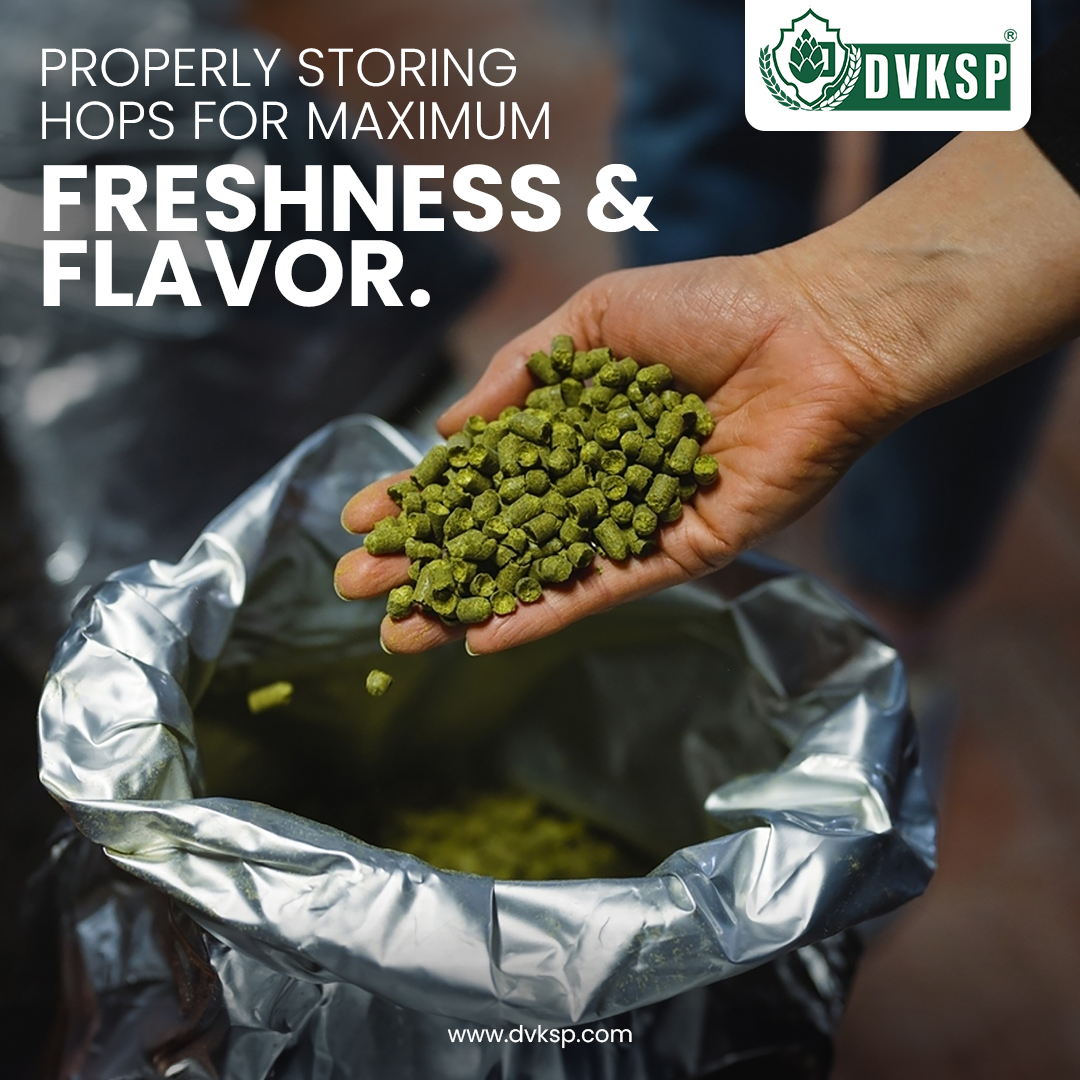How to Store Hops & Get Maximum Freshness & Flavour in Your Beer.
The best & right method to properly Store Hops for Maximum Freshness & Flavor for a longer lifespan.
We at DVKSP Impex in our 12+ Warehouses worldwide follow the below process for keeping our loved hops in their premium & high quality.
By following the below process, we can successfully lock in & maintain the quality & freshness of hops that they had when they were picked from the hops fields at the time of Hops harvesting.
For brewers, few ingredients are as precious and potent as hops.
These cone-like flowers deliver the bitterness, aroma, and flavor that define many of our favorite beer styles.
However, hops are also extremely perishable and can lose their brilliant essential oils rapidly if not stored properly.
After reading this blog post, you will have a clear understanding and answers to all the below questions.
- How to store your hops to get the best brew from them?
- What precautions and steps you should take before you start storing your hops?
- Which is the right temperature to store hops for a longer lifespan?
- How to sterilize your storage once your stock is cleared?
- Should I vacuum reseal the bag or rewrap the bag, once I have opened the bag?
- Do I need to sterilize my cold storage space before storing a new stock of hops?
- Which is the right way to clean & prepare my cold storage space for storing my new hops stock in my cold storage?
Let us go through each of the above questions in depth together and understand what you should do and how you should do it.
The right way of storing hops to maintain maximum freshness requires controlling four key factors:
-
Temperature,
-
Humidity,
-
Light, and
-
Oxygen exposure.

How to Store Hops & Get Maximum Freshness & Flavors in Your Beer.
Let’s dive into why each is highly critical and how they work together.
Temperature Control: The Cornerstone of Hops Preservation.
- Low temperatures are vital for slowing down the degradation of hop resins and oils. The ideal storage temperature is below freezing, around 0°F (-18°C) or colder.
- At these frosty conditions, the precious alpha and beta acids in hops remain stable for up to 2 years.
- However, every 10°F increase in temperature can cut that lifespan by 50% due to accelerated oxidation.
- Refrigerator temperatures around 38°F (3°C) are acceptable for a few months but nowhere near as effective as a deep freeze.
Managing Moisture: Preventing Premature Degradation
- While freezing slows the aging process, moisture enables it through accelerated oxidation and microbe growth.
- That’s why hops must have a moisture content below 10% before storage.
- Most hops are dried to around 8% right after harvest and processing. Any exposure to humidity, spills, or condensation during storage can diminish freshness and introduce off-flavors.
- Air-tight packaging is essential to lock out moisture.
Light Exposure: Keeping Hops in the Dark
Another factor that rapidly degrades hops is light exposure, especially in the ultraviolet spectrum.
- UV rays initiate oxidation of the polyphenol compounds that contribute bitterness, flavors, and aromas.
- Direct sunlight is obviously a no-no, but even fluorescent lighting can be problematic over time.
- Protecting hops in light-proof containers is crucial throughout the storage and handling process.
Limiting Oxygen: A Battle Against Oxidation
- Finally, we come to the enemy that accelerates all forms of hop degradation – oxygen.
- Oxidation causes the gradual loss of desirable resins, oils, and aromas while creating harsh, rasping off-flavors associated with old hops.
- Purging and vacuum-sealing containers with oxygen-absorbing packets helps minimize contact with ambient air.
- The best way is flushing with inert gases like nitrogen, argon, or CO2 before sealing.
Interdependency of the Factors to Store Hops: The Best Approach to Maintain Premium Quality of Hops.
- While each of these factors is undeniably important, their interdependent relationship makes hop storage so challenging.
- For example, high humidity accelerates oxidation, while cool temperatures slow it down.
- Exposure to light and oxygen is far more detrimental at warmer temperatures.
- Protecting against one risk factor while neglecting another can undo all your efforts.
- That’s why a comprehensive, integrated approach is vital, from handling to packaging.
Before Storage: Preparation is Key.
Of course, proper storage is just the final piece of the puzzle. The preparation beforehand is just as critical to preserving the precious hop’s flavors, aroma, acid levels & oil content.
Post-Harvest Handling – Hops must be carefully dried, packaged in moisture-barrier bags, and chilled immediately after picking to halt respiration and lock in peak qualities.
Moisture Check – Using a calibrated moisture meter, confirm the hops have reached the target 8% or lower moisture content before packaging for storage.
Oxygen Purge – Modern packaging lines flush the air out and replace it with nitrogen, CO2, or a Nitrogen/CO2 blend, then vacuum-seal the hop pouches.
Labeling – Clear labeling with varietal name, harvest date, alpha acid percentage, and any lot numbers is essential for traceability and rotation.
Cold Transport – Any delay between packaging and getting the hops into cold storage risks degradation, so they must be immediately chilled and transported at cold temperatures.
Cleaning and Beyond: Reset for Freshness
Finally, after your hops are happily consumed, the cycle begins again with diligent cleaning and preparation for the next batch:
Equipment Cleaning – Vacuum packaging machines, moisture meters, and any other equipment that contacts hops need thorough cleaning and sanitation. Leftover hop particles or oils can enable oxidation and introduce contaminants.
Storage Area Reset – Walk-in freezers and coolers must have any hop litter removed. Sanitize shelving and interiors before restocking to eliminate microbes. Check seals on doors to prevent moisture and temperature fluctuations.
Purge for Freshness – If using controlled atmosphere storage, flush out any stale and oxygen-depleted air from the cooler before receiving new hop shipments.
Incoming Inspection – As new hops arrive, spot-check packages for any signs of temperature abuse or moisture during transit. Proper cold-chain handling must be verified.
Maintaining Freshness After Opening: Once a package of hops has been opened, promptly resealing it is crucial to preserve the remaining contents.
Brewers have two main options:
- Vacuum Resealing:
The ideal approach is to reseal the original foil package using a commercial chamber vacuum sealer.
These specialized sealers can accommodate large hop bags and have inert gas back-flushing capabilities to purge oxygen before resealing.
You can do this in two ways: 1) Buy a new one or 2) Get a used one from any cold storage warehouse.
This vacuum sealer provides excellent hop longevity. The vacuumed foil package protects against oxidation while allowing the hops room to move freely.
For those without access to a commercial vacuum sealer, an effective alternative is repackaging the remaining hops in vacuum-sealable plastic bags using a household vacuum sealer.
While not as oxygen-barrier as the foil, this limits air exposure far better than regular storage bags.
- Rewrapping:
If vacuum resealing isn’t an option, brewers should carefully squeeze out as much air as possible from the opened foil package before tightly rewrapping and sealing it closed with tape.
The goal is to make the resealed package as airtight as possible. Using plastic wrap can provide an extra air barrier when rewrapping foil packages.
No matter which resealing approach is taken, the key is minimizing oxygen exposure to the remaining hops and promptly returning them to cold storage temperatures of 35-41°F (1-5°C) or lower.
While not quite as effective as an unopened vacuum-sealed package, proper resealing can extend the freshness of opened hops for weeks or months until fully consumed.
Conclusion: Hops Storing is a delicate, multi-faceted process from handling to packaging, storage conditions to cleaning, comprehensive practices are needed to protect the quality and freshness brewers demand, and doing this ensures our precious hops deliver maximum flavor and aroma in every brew of yours.
Let us know, What is your process for maximizing the quality of the hops.
Till then, Cheers to all the brewers who leave no stone unturned to make each sip of their brew an experience that creates beautiful memories.


Leave a Reply
Want to join the discussion?Feel free to contribute!